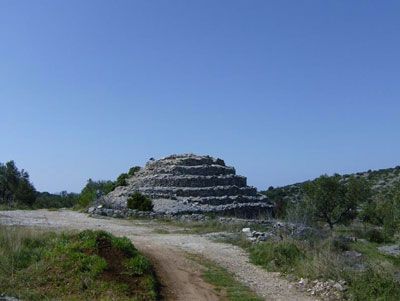The first written data about Jezera date back to the year 1298. But, the town is much older. We can find traces of an Illyrian settlement from the 11th century BC on the peninsula Murtarić near the present-day town. Not far from the town, in the bay of Podjasenovac, two graves of the Illyrian tribe Liburna were found in a barrow in the year 1938. There are many similar barrows in the vicinity of the town. There is one large barrow that stands out and looks like a truncated cone and one climbs to its top by following a spiral path. The town inhabitants call it «Pudarica» because pudari, i.e. fielders used to keep the fields there in the old days. However, although it dominates over a large area of vineyards, orchards and olive groves, it is more towards the sea, over the Murtar bay (St. Nicholas). Don Krsto Stošić in his work «Villages of the Šibenik District» (1941) believes that this was built by Illyrians who were there before Croatian inhabitants (Illyrians, Celts) that served as a watchtower over the bay and from this area signs were given to the fleet from which came the names of the hill and bay, an later the island Mor-tar which means sea fort or castle. There were a few similar buildings in the ancient times that were located on the southeast side of the Island of Murter.
Jezera, since the year 1602, has its own parish. In 1722, The Parish of Our Lady of Health was built with beautiful stone plates from the local quarries at the site of the old church. Next to the Church, on the east side, there is a bell tower that is 32m high. Which is also the oldest bell tower on the Island of Murter. The Church has a single nave with one main and two side chapels. There are seven altars and two balconies making it a nice example of Mediterranean Baroque. The main altar contains a bas-relief that stands out of Mary with baby Jesus plated in silver and gold. The altar of Our Lady of Seven Sorrows is particularly interesting and it is also considered to be one of the most beautiful wooden altars in all of Dalmatia.
The Church Saint John of Trogir, in the cove, from the 17th century, houses the local heritage exhibition.
The small Church of Saint Rocco, located in the field, is from the 16th century. The small Church of Saint Constance is located on the hill Kružak and was built in 1780 as a votive church of the patron of malaria, or the high fever that accompanied the disease. For the most part, local residents who were suffering from malaria built this Church. The Church was destroyed in World War II, however in 1994 it was rebuilt with the solidarity of people from Jezera. In the bay of Murter, which is still called Saint Nicholas, stands the Church Saint Nicholas from the 15th century, which was renovated in 2012.
On May 10, 1911 the Society of Jezera seafarers was founded. On the memorial day of the founding and renewal of the Church Saint Nicholas (restored in 2011) decorated boats move towards the bay where a solemn mass is held along with a special program. The majority of files and last testaments, in respect to the town, come from the 15th, 16th and 17th centuries, and they were mainly written in Glagolitic, Bosnian Cyrillic and Latin. In particular, Glagolitic literacy was long developed and carefully cherished which was spoken about in the already mentioned book of Stošić: between 1750-1780, 11 priests died which were all natives of Jezera, as well as the mentioning of another 10 priests and friars from Jezera who served elsewhere. They were all Glagolitic and aided the establishment of the confraternity (brašćina).
Jezera is a settlement with a specific physiognomy. We distinguish the topological characteristics of the three separate parts, which are today linked by modern construction. The youngest part of the settlement, the Sea, stretches along the coast of the bay. Of all the places on the island, Jezera was the first settlement that began building houses, during the mid – 18th century, right by the sea, most of them being summerhouses. By that time, there was already the danger of robbers from southern Italy, so the settlement was built in a compact matter about 400 m from the sea, which was evidenced by two of the older forms of settlements Selo (village) and Košuluk.






















